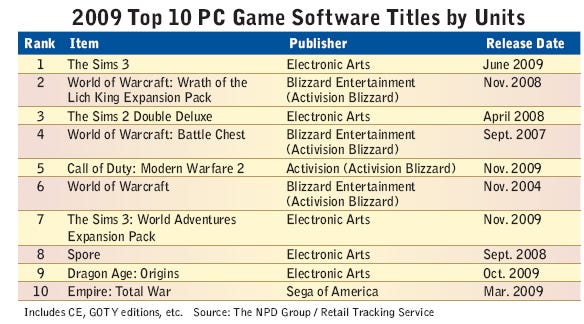Massively multi-player online games (MMOGs) are a unique gaming genre offering the ability to interact and play with hundreds to thousands of players. NPD's recent online gaming 2010 study, fielded in January 2010, shows
April 6, 2018

Massively multi-player online games (MMOGs) are a unique gaming genre offering the ability to interact and play with hundreds to thousands of players. NPD's recent online gaming 2010 study, fielded in January 2010, shows how the landscape has changed over the past few years. Three years of trending shows that the incidence of gamers playing MMOGs on PCs has decreased by 6 percent since the 2008 study. Perhaps this decline is due to consumers moving to other types of games or entertainment media. 

Though PC-boxed retail games declined 19 percent in unit sales in 2009, MMOGs declined to a greater degree than the overall retail PC game market, with a 55 percent unit decline over 2008, according to NPD data.
However, one of the most popular MMOGs, Blizzard Entertainment's World of Warcraft, has had success selling through digital distribution. Micro-transactions, sales of the initial game and ad-based revenue are just a few of the ways MMOGs can generate revenue. Many require a monthly subscription fee; NPD's Subscription Tracker measured the subscription revenue generated by MMOGs at $50.4 million in fourth quarter 2009. However, this is a 7 percent decline from $54.3 million in fourth quarter 2008. The constant revenue stream generated by MMOGs makes this business model attractive, but gamers also demand new content and can tire of a subscription if updates are not provided.
World of Warcraft is a game that has almost become synonymous with massively multi-player online gaming. This title has generated 3.8 million in unit sales at retail since its launch in November 2004, with subsequent expansions totaling 5.3 million unit sales through January 2010. NPD research shows 30 percent of those playing MMOGs on their PCs are currently playing Word of Warcraft, which is the highest percentage of any game covered in the study.
WoW also has success selling through digital distribution, as the top three PC digital games sold from January to September 2009 were World of Warcraft or its expansions. Even though the percentage of MMOGs being played has decreased, WoW participation increased by 4 percent among current MMOG players.
The influence of free gaming is seen in the rise in the number of MMOG players playing Dungeons and Dragons Online since January 2009. Dungeons and Dragons Online has moved from 11th place to third in terms of incidence of MMOG players currently playing the game. The factor that likely contributed most to this meteoric rise was the change to a hybrid subscription/free-to-play business model, along with releasing new content in September 2009. In fact, Dungeons and Dragons Online had the highest increase among former World of Warcrafters that moved to the game since 2009. This may point to an effect of the economy on gaming behavior as consumers try to save money by moving to a free MMOG alternative, as well as gamers looking for fresh content.
When looking at who is playing MMOGs, the majority of gamers (68 percent) are male. Those ages 25 to 34 comprise the largest age group, and 30 percent of these gamers report they are playing for 20+ hours per week.
The gaming industry is a diversified landscape, with multiple platforms, distribution points and business models all competing for consumers' gaming dollars. MMOGs are just one facet of the industry, and they have their own unique challenge of continuing to keep the user base entertained enough to justify paying subscription fees or micro-transactions. As the industry evolves, it will be interesting to see what changes will occur in the massively multi-player online games space over the coming years.
You May Also Like






